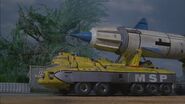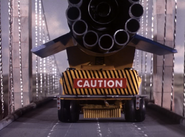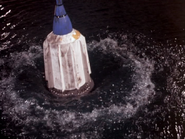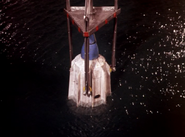The Martian Space Probe (also referred to as the MSP) is a space rocket featured in Day of Disaster. The launch sequence of the spacecraft was built to be completely automatic, initiating when the craft was put upright into its launch position.
Due to the horrifying crash of the first Zero-X, the Martian Space Probe program saw a window of opportunity for launch. The Zero-X and the MSP program wanted to be the first on Mars, and it appeared as if the MSP would be first.
However, this all changed when the Allington Suspension Bridge collapsed, sending the transport Vehicle and the rocket plummeting to the bottom of the river. The intervention of International Rescue saved the lives of the two U.S. technicians aboard the probe: Bill Craddock and Frank.
Journey To England[]
At Cape Kennedy, a specially constructed loading facility transfers the MSP to a twin-hulled tanker for its journey by sea to Great Britain. A similar facility on the English coast, transfers the spaceship onto its carrier for the remaining journey by road to the pre-prepared launch site.
Transporter and Trailer[]
- Main article: Martian Space Probe Transporter Vehicle
Design[]
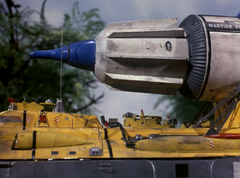
The Martian Space Probe had the accelerometers and sensors inside the blue part of the nose cone. Behind the blue nose part was the control room (the interior seen in Day of Disaster). It had seating for two people as well as a starboard and port viewing hatch. Underneath the control room was the life-support system. Behind the control room was a sleeping room for two people. Behind the sleeping room are the retro rockets with built-in docking sensors. The nose cone also had a blast shield. There was also an airlock tunnel in the nose capsule that could be used to get to the laboratory and another sleeping room for six other people in the main body. Behind the laboratory and the sleeping room was a atomic reactor with a pile, the gas turbines, and the anti-radiation shielding. Behind the atomic reactor, the pile, and the gas turbines were the generators, propellant tanks, ion rockets, the ion electrostatic acceleration chamber, and the rocket nozzles at the very rear end of the ship. The Martian Space Probe also had several blue solar panels that could be used with the life-support system.
Technical Data[]
Martian Space Probe[]
- Automatic countdown duration: 12 hours
- Built by: Rosenthal Industries Incorporated
- Crew: two
- Crew accommodation: command module incorporating gimballed seats for pilot and co-pilot, engineering station, crew quarters (including recreation area) and laboratories (port side)
- Designed by: Professor Wingrove
- Engines: ion drive particle accelerators and chemical rockets
- Launch thrust: 10 million kgs
- Length: 103 metres
- Power source: atomic fusion reactor
- Propulsion: Three rear-mounted chemical rocket engines
- Secondary power source: gas turbine driven electro-static generator powers the gravity and life support systems
- Structure: cahelium-strengthened hull
- Total crew: six
- Weight: 1,968 tonnes
Transporter[]
- Crew: driver and co-driver
- Power source: nuclear-powered reactor
- Structure: cahelium-strengthened body with weight-bearing suspension stanchions to distribute weight of the rocket evenly
- Wheels: 28
Crew[]
The Space Probe had a crew of two: Bill Craddock and Frank
Destruction[]
- Main article: A Race Against Time
Cutaway Drawings[]
- Main article: History of the Cutaway Drawings (Classic Thunderbirds)
As far as is known, only three cutaway drawings of the Martian Space Probe (as well as its transporter) exist. Additionally, all three of the aforementioned cutaways were illustrated by Graham Bleathman.
- The first appeared in a Fleetway comic No.22
- The second appeared in a Redan comic No.47
- And finally, the third featured in the Haynes Thunderbirds manual.













